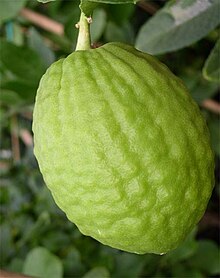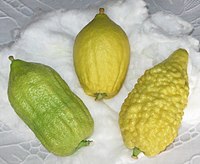
Kumquats, or cumquats in Australian English, are a group of small, angiosperm, fruit-bearing trees in the family Rutaceae. Their taxonomy is disputed. They were previously classified as forming the now-historical genus Fortunella or placed within Citrus, sensu lato. Different classifications have alternatively assigned them to anywhere from a single species, C. japonica, to numerous species representing each cultivar. Recent genomic analysis defines three pure species, Citrus hindsii, C. margarita and C. crassifolia, with C. x japonica being a hybrid of the last two.

Citrus is a genus of flowering trees and shrubs in the rue family, Rutaceae. Plants in the genus produce citrus fruits, including important crops such as oranges, lemons, grapefruits, pomelos, and limes. The genus Citrus is native to South Asia, East Asia, Southeast Asia, Melanesia, and Australia. Various citrus species have been used and domesticated by indigenous cultures in these areas since ancient times. From there its cultivation spread into Micronesia and Polynesia by the Austronesian expansion ; and to the Middle East and the Mediterranean via the incense trade route, and onwards to Europe and the Americas.

The mandarin orange, also known as mandarin or mandarine, is a small, rounded citrus tree fruit. Treated as a distinct species of orange, it is usually eaten plain or in fruit salads. Tangerines are a group of orange-coloured citrus fruit consisting of hybrids of mandarin orange with some pomelo contribution.

Etrog is the yellow citron or Citrus medica used by Jews during the week-long holiday of Sukkot as one of the four species. Together with the lulav, hadass, and aravah, the etrog is taken in hand and held or waved during specific portions of the holiday prayers. Special care is often given to selecting an etrog for the performance of the Sukkot holiday rituals.

A lime is a citrus fruit, which is typically round, green in color, 3–6 centimetres (1.2–2.4 in) in diameter, and contains acidic juice vesicles.

The citron, historically cedrate, is a large fragrant citrus fruit with a thick rind. It is said to resemble a 'huge, rough lemon'. It is one of the original citrus fruits from which all other citrus types developed through natural hybrid speciation or artificial hybridization. Though citron cultivars take on a wide variety of physical forms, they are all closely related genetically. It is used in Asian and Mediterranean cuisine, traditional medicines, perfume, and religious rituals and offerings. Hybrids of citrons with other citrus are commercially more prominent, notably lemons and many limes.

Citrus × meyeri, the Meyer lemon, is a hybrid citrus fruit native to China. It is not a lemon, but is instead a cross between a citron and a mandarin/pomelo hybrid.

Citrus medica var. sarcodactylis, or the fingered citron, is an unusually-shaped citron variety whose fruit is segmented into finger-like sections, resembling those seen on representations of the Buddha. It is called Buddha's hand in many languages including English, Chinese, Japanese, Korean, Vietnamese, and French.
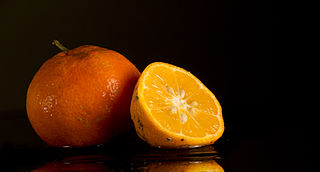
Rangpur, Citrus × limonia or Citrus reticulata × medica, sometimes called the rangpur lime, mandarin lime or lemandarin, is a hybrid between the mandarin orange and the citron. It is a citrus fruit with a very acidic taste and an orange peel and flesh.

Sweet lemon and sweet lime refer to groups of citrus hybrids that contain low acid pulp and juice. They are hybrids often similar to non-sweet lemons or limes, but with less citron parentage. Sweet limes and lemons are not sharply separated:
The sweet lime, Citrus limettioides Tan., is often confused with the sweet lemon, C. limetta Tan., which, in certain areas, is referred to as "sweet lime". In some of the literature, it is impossible to tell which fruit is under discussion.

The ponderosa lemon is a citrus hybrid of a pomelo and a citron. It is not the same as the 'Yuma Ponderosa' lemon-pomelo hybrid used as citrus rootstock.
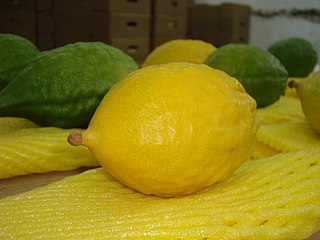
The Diamante citron is a variety of citron named after the town of Diamante, located in the province of Cosenza, Calabria, on the south-western coast of Italy, which is its most known cultivation point. This is why this variety is sometimes called the "Calabria Esrog". "Esrog" is the Ashkenazi Hebrew name for citron.

Succade is the candied peel of any of the citrus species, especially from the citron or Citrus medica which is distinct with its extra-thick peel; in addition, the taste of the inner rind of the citron is less bitter than those of the other citrus. However, the term is also occasionally applied to the peel, root, or even entire fruit or vegetable like parsley, fennel and cucurbita which have a bitter taste and are boiled with sugar to get a special "sweet and sour" outcome.

The Moroccan citron is a true citron variety native to Assads, Morocco, which is still today its main center of cultivation.

The lemon is a species of small evergreen tree in the flowering plant family Rutaceae, native to Asia, primarily Northeast India (Assam), Northern Myanmar, and China.
The micrantha is a wild citrus from the papeda group, native to southern Philippines, particularly islands of Cebu and Bohol. Two varieties are recognized: small-flowered papeda, locally known as biasong, and small-fruited papeda or samuyao.

The lumia is also called the pear lemon, since its shape resembles a pear. It is also called French lime and sometimes sweet lemon, even though it is not necessarily sweet.

Rhobs al-Arsa is a very popular citrus fruit in Morocco.

Citrus taxonomy refers to the botanical classification of the species, varieties, cultivars, and graft hybrids within the genus Citrus and related genera, found in cultivation and in the wild.
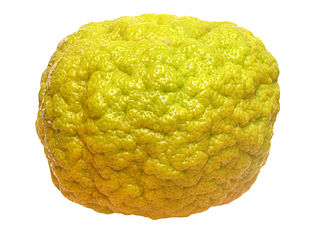
Pompia, also called pumpia, sa pompia, spompia, and China citron, is a Citrus hybrid cultivated for its edible fruit. It is a taxonomical synonym of Citrus medica.
